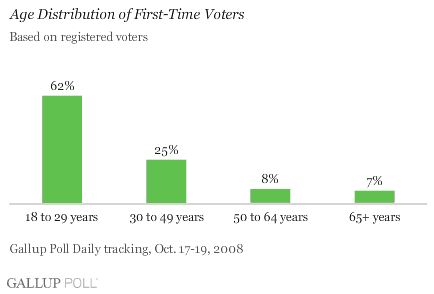PRINCETON, NJ -- Gallup finds 13% of registered voters saying they will vote for president for the first time in 2008. That matches the figure Gallup found in its final 2004 pre-election poll.

The current data are based on interviews with more than 2,700 registered voters as part of Oct. 17-19 Gallup Poll Daily tracking. Gallup asked these voters a question it had asked in its 2004 election polling: whether this would be the first time they had voted in a presidential election, or whether they had voted for president before. Despite much discussion of the possibility of large numbers of new voters in 2008, the percentage of "first time" voters in Gallup polling this election cycle is no higher than it was at approximately the same time in 2004.
The estimate of first-time voters is slightly lower, 11%, using Gallup's expanded likely voter model. Under this model, Americans who are registered to vote, who say they plan to vote, who indicate they have given "quite a lot" of thought to the election, and who rate their chances of voting as a "9" or "10" on a 10-point scale are deemed likely to vote. Gallup's traditional likely voter model takes into account past voting behavior as well as current voting intentions, but because it adjusts for voters who were too young to vote in past elections, it still estimates that 8% of likely voters will be voting for the first time.
Who Are First-Time Voters?
Perhaps not surprisingly, the signature characteristic of first-time voters is their youth. Among registered voters, 62% of those who say they will be voting for the first time are below age 30, including one in five who are the minimum voting age of 18. First-time voters aged 30 or older are predominantly between the ages of 30 and 49.

Given this decidedly young age distribution, it is not surprising that first-time voters exhibit many other characteristics of young adults.
- Forty-eight percent of first-time voters report that they are full-time students.
- Nearly half of first-time voters (47%) come from a racial or ethnic minority group. That is higher than the proportion of first-time voters who were minorities in 2004 (33%), and could reflect the historic nature of Barack Obama's candidacy.
- Forty percent of first-time voters identify themselves as Democrats, 37% as independents, and only 23% as Republicans.
- Thirty-two percent of first-time voters describe their political views as conservative, 34% as moderate, and 28% as liberal. That is a much closer conservative-liberal split than is true of the general public, in which conservatives outnumber liberals by about 2 to 1.
First-time voters show solid support for Obama, 65% to 31%. That is a better showing for the Democratic candidate than in 2004, when first-time voters favored John Kerry over George W. Bush by 55% to 41%.
Bottom Line
Each presidential election brings a new wave of voters into the electoral process. And although there is speculation that Obama's candidacy -- given his appeal to young and minority voters -- could bring an unusually large number of first-time voters to the polls this year, the proportion of registered voters who say they will be voting for the first time is no higher than it was in 2004. This to some degree may reflect the high turnout in 2004, which was about 10 points higher than it had been in recent elections, and thus would have significantly diminished the available pool of potential first-time voters for the 2008 election. Thus, the fact that the 2008 estimate of first-time voters is no lower than the 2004 estimate may still reflect an impressive influx of new voters this year, even though it may not be proportionately higher than in the last election.
Survey Methods
Results are based on telephone interviews with 3,030 national adults, aged 18 and older, conducted Oct. 17-19, 2008, as part of Gallup Poll Daily tracking. For results based on the total sample of national adults, one can say with 95% confidence that the maximum margin of sampling error is ±2 percentage points.
For results based on the sample of 2,774 registered voters, the maximum margin of sampling error is ±2 percentage points.
For results based on the sample of 197 registered voters who will be voting for the first time, the maximum margin of sampling error is ±8 percentage points.
Interviews are conducted with respondents on land-line telephones (for respondents with a land-line telephone) and cellular phones (for respondents who are cell-phone only).
In addition to sampling error, question wording and practical difficulties in conducting surveys can introduce error or bias into the findings of public opinion polls.
